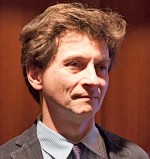Title
A December doctoral forum and performance provided some intriguing insights via different manuscripts into the composition of one of Claude Debussy’s song cycles. The talk was given by Debussy scholar Denis Herlin, the director of research at Institut de recherche sur le patrimoine musical en France (Institute for Research Into France’s Musical Heritage).
Body
Herlin’s talk was called From Debussy’s Studio: The Little-Known Autograph Manuscript of “De Rêve,” the First of the Proses Lyriques (1892). The beautiful but little-known “De Rêve” is part of Proses Lyriques, which is one of Debussy’s more daunting song cycles. This 1892 version of the manuscript is housed in the Juilliard Manuscript Collection; Herlin compared it with the much more well-known 1895 Stichvorlage (printer’s copy), which is at the Morgan Library.
Herlin first discussed the historical context of the song and then presented his findings from a measure-by-measure comparison of the two manuscripts. One of the reasons the subject matter was particularly interesting is that, as Graduate Studies faculty member Philip Lasser (D.M.A. ’94, composition) told The Journal, “it’s rare to see two definitive Debussy manuscripts of the same work side-by-side since the composer generally destroyed earlier versions of his works, leaving us with only one ‘final’ version.”
Herlin’s research included photographs of some of the dedicatees of the songs, including Jeanne Chausson (the wife of composer Ernest Chausson) and Henry Lerolle, part of Debussy tight circle of contemporaries. In choosing to write and set his own poetry in the Proses Lyriques, Debussy’s goal was to liberate a text from its traditional meter. Inspired by the symbolist poet Mallarmé—also part of his circle—Debussy broke away from the more rigid structure of previous poems he’d set (by, among others, Verlaine and Baudelaire), making the Proses Lyriques much more free-form than his settings..
Herlin’s well-researched story was enhanced with performances of selections from the 1892 and 1895 manuscripts by first-year master’s mezzo-soprano Virginie Verrez (B.M. ’13, voice) and collaborative piano doctoral student Bretton Brown. Jane Gottlieb, Juilliard’s vice president for library and information resources and the organizer of Juilliard’s doctoral forum series, told The Journal that it was “particularly illuminating to see slides of the manuscripts and then hear the differences in performance.”
For example, in the Juilliard manuscript, changes of registration in the vocal line enable the text to be more pronounced and clear than in the Morgan Library version. Also there are interesting differences between the two manuscripts with regard to the last piano chord: the Juilliard manuscript has no fermata on it but it’s followed by rests; the Morgan version of the same section has a fermata but no rests following it. Yet Herlin’s most significant discovery was evidence of a potential, orchestrated version of the songs. The Morgan manuscript’s incredibly deep, sustained bass notes make it impossible to play everything as written in the piano part simply because one’s hand cannot stretch or grab all these notes. The Juilliard version, however, shows some smaller, red-ink sketches by Debussy that indicate an in-process orchestration; it appears that he even began to distribute these parts, particularly to the first violin. This is significant because of the aforementioned difficult writing for the piano, and it is now evident that the composer had originally attempted to address that issue. Also, rather than merely breaking chords, the Juilliard manuscript’s piano writing enables a pianist to actually play the notes simultaneously, as written.
So why is the later version more well-known despite what might seem to be the advantages of the earlier one? “Generally we believe that a composer makes changes for the better and tend to side with his decisions and go with the later manuscript,” Lasser said, but Herlin’s research shows us that perhaps sometimes those assumptions should be challenged. “The fact that we can compare two equal documents with their with their changes can also allow the performer to come up with his or her own decisions as to which is more moving,” Lasser added.
Herlin’s research also underscored one of the great strengths of the Juilliard manuscript collection: it can give us insights into the process of composing great works in addition to just the works themselves. “The ability to showcase one of our rare manuscripts along with excellent student performances and cutting-edge research made this forum one of the highlights of the season,” Gottlieb said, adding that “it’s very exciting that Juilliard can be at the center of such research.”





